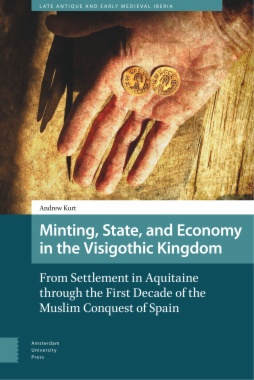This study of the Visigothic kingdom monetary system in southern Gaul and Hispania from the fifth century through the Muslim invasion of Spain fills a major gap in the scholarship of late antiquity. Examining all aspects of the making of currency, it sets minting in relation to questions of state - monarchical power, administration and apparatus, motives for money production - and economy. In the context of the later Roman Empire and its successor states in the west, the minting and currency of the Visigoths reveal shared patterns as well as originality. The analysis brings both economic life and the needs of the state into sharper focus, with significant implications for the study of an essential element in daily life and government. This study combines an appreciation for the surprising level of sophistication in the Visigothic minting system with an accessible approach to a subject which can seem complex and abstruse.
- Cover
- Table of Contents
- Acknowledgments
- Introduction
- 1. Pre-Regal Visigothic Coinage
- A. The Fifth-Century Kingdom in Gaul
- B. The Kingdom in Spain, 507-c. 573
- 2. The King’s Coinage: The Beginning and Development of the Regal Coinage (c. 573-c. 720)
- A. The Transition to a Regal Coinage
- B. Regal Coin Types
- C. A Trimetallic System?
- 3. The Activities of the Mints from c. 573- c. 720
- A. The Operation of the Mints
- B. The Record of Mint Output
- C. The Organization of the Mints
- D. Metrological and Metallurgical Standards of Visigothic Regal Tremisses
- 4. Why Were Gold Coins Struck in the Visigothic Kingdom?
- A. The Late Roman Context
- B. Other Reasons for Minting
- C. The Addition of Bronze to the Corpus
- D. Visigothic Minting in the Context of Contemporary Monetary Systems
- 5. The Royal Control of Visigothic Minting
- A. Evidence of Royal Control
- B. The Significance of Centralized Monetary Authority
- 6. Coinage in Spain in the Aftermath of the Islamic Conquest
- 7. Visigothic Currency in the Early Medieval Economy
- A. The Other Side of the Coin
- B. Use and Circulation of Currency in the Kingdom
- C. Bronze Currency in Spain and its Mediterranean Context
- Conclusion
- Appendix I
- Appendix II
- Bibliography
- About the Author
- Index
- List of figures
- Figure 1: Frequencies of Weights of Tremisses in the Name of Anastasius
- Figure 2: Frequencies of Weights of Tremisses in the Name of Justin I
- Figure 3: Frequencies of Weights of Tremisses in the Name of Justinian
- Figure 4: Frequencies of Weights of Tremisses in the Name of Justin II
- Figure 5: Frequencies of Weights of Pre-regal Tremisses Arranged by Attributed Mints or Minting Regions
- Figure 6: Timeline of gold coin sets - estimated chronologies and metrological values
- Figure 7: Proposed order of hoard contents related to Leovigild’s regal-name minting
- Figure 8: Tremissis standards from averages immediately prior to and during Leovigild’s reign
- Figure 9: Proposed chronology of the earliest Visigothic regal issues
- Figure 10: Principal early facing-busts type forms297
- Figure 11: Diagram of the patrimony’s divisions and the flow of proceeds into the fiscus
- Figure 12: Difference in average regal tremissis weights between central and peripheral mints
- Figure 13: Gold content of tremisses leading up to Leovigild’s facing-busts phase
- Figure 14: Coinage within the kingdom’s political-economic system
- Figure 15: Transitional dinar in Latin letters of 94H = 712-713 (ANS, currently catalogued as HSA 57.1255)
- Figure 16: Bilingual dinar of 98H = 716-717 (ANS 1994.55.1)
- Figure 17: Thulth (1/3 dinar) in Arabic of 102H = 720-721 (ANS 1917.215.3437)
- Figure I.1: Weight and fineness measurements of Visigothic pre-regal tremisses at the ANS
- Figure I.2: Comparison of intrinsic values between tremisses of Byzantine Spania, Constantinople and the Visigothic Kingdom
- Figure I.3: Graph comparison of intrinsic values – tremisses of Byzantine Spania, Constantinople and the Visigothic Kingdom
- Figure I.4: Map of gold mints in Visigothic Spain (c. 575 – c. 714)
- Figure I.5: Schema of bust types of Visigothic regal tremisses
- Figure I.6: Visigothic copper-alloy coins compared to tremisses
- Figure I.7: Table of known regal mints
- Figure I.8: Number of known mints from each reign
- Figure I.9: Southern mints’ percentage of total corpus
- Figure I.10: Individual mints’ percentage of total in southern-central Visigothic Spain
- Figure I.11: Weight and fineness measurements by Lauris Olson of 377 Visigothic regal tremisses
- Figure I.12: Averages of fineness and other measurements of gold coins at the ANS
- Figure I.13: Frequencies of weights of Visigothic regal tremisses
- Figure I.14: Average weights of tremisses at mints of diverse volumes of output
- Figure I.15: Percentage of fineness in Visigothic tremisses of three major samples
- Figure I.16: Average fineness of 238 tremisses tested using X-ray fluorescent spectrometry method
- Figure I.17: Fineness of Visigothic pseudo-imperial tremisses, Visigothic regal tremisses, and early Muslim dinars in Spain
- Plate I
- Plate II
- Plate III
- Plate IV
- Plate V
- Tables of Regal Visigothic Tremisses Attributed to SeparateEngravers
- Concordance of new ANS accession numbers for ex-HSA regal Visigothic tremisses

